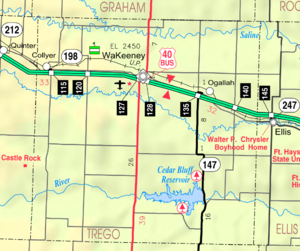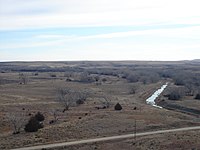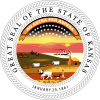Trego County, Kansas
Trego County | |
|---|---|
County | |
 Trego County Courthouse in WaKeeney (2017) | |
 Location within the U.S. state of Kansas | |
 Kansas's location within the U.S. | |
| Coordinates: 39°00′30″N 100°03′54″W / 39.0083°N 100.065°W | |
| Country | |
| State | |
| Founded | June 21, 1879 |
| Named for | Edgar Poe Trego[1] |
| Seat | WaKeeney |
| Largest city | WaKeeney |
| Area | |
| • Total | 900 sq mi (2,000 km2) |
| • Land | 889 sq mi (2,300 km2) |
| • Water | 10 sq mi (30 km2) 1.1% |
| Population | |
| • Total | 2,808 |
| • Density | 3.2/sq mi (1.2/km2) |
| Time zone | UTC−6 (Central) |
| • Summer (DST) | UTC−5 (CDT) |
| Congressional district | 1st |
| Website | TregoCountyKS.com |
Trego County (standard abbreviation: TR) is a county located in the U.S. state of Kansas. As of the 2020 census, the county population was 2,808.[2] Its county seat and largest city is WaKeeney.[3]
History[]
Early history[]
For many millennia, the Great Plains of North America was inhabited by nomadic Native Americans. From the 16th century to 18th century, the Kingdom of France claimed ownership of large parts of North America. In 1762, after the French and Indian War, France secretly ceded New France to Spain, per the Treaty of Fontainebleau.
19th century[]
In 1802, Spain returned most of the land to France, but keeping title to about 7,500 square miles. In 1803, most of the land for modern day Kansas was acquired by the United States from France as part of the 828,000 square mile Louisiana Purchase for 2.83 cents per acre.
In 1854, the Kansas Territory was organized, then in 1861 Kansas became the 34th U.S. state. In 1879, Trego County was established.
Geography[]
According to the U.S. Census Bureau, the county has a total area of 900 square miles (2,300 km2), of which 889 square miles (2,300 km2) is land and 10 square miles (26 km2) (1.1%) is water.[4]
Adjacent counties[]
- Graham County (north)
- Rooks County (northeast)
- Ellis County (east)
- Ness County (south)
- Gove County (west)
Major highways[]
 Interstate 70
Interstate 70 U.S. Route 40
U.S. Route 40 U.S. Route 283
U.S. Route 283 K-147
K-147
Demographics[]
| Historical population | |||
|---|---|---|---|
| Census | Pop. | %± | |
| 1870 | 166 | — | |
| 1880 | 2,535 | 1,427.1% | |
| 1890 | 2,535 | 0.0% | |
| 1900 | 2,722 | 7.4% | |
| 1910 | 5,398 | 98.3% | |
| 1920 | 5,880 | 8.9% | |
| 1930 | 6,470 | 10.0% | |
| 1940 | 5,822 | −10.0% | |
| 1950 | 5,868 | 0.8% | |
| 1960 | 5,473 | −6.7% | |
| 1970 | 4,436 | −18.9% | |
| 1980 | 4,165 | −6.1% | |
| 1990 | 3,694 | −11.3% | |
| 2000 | 3,319 | −10.2% | |
| 2010 | 3,001 | −9.6% | |
| 2020 | 2,808 | −6.4% | |
| U.S. Decennial Census[5] 1790-1960[6] 1900-1990[7] 1990-2000[8] 2010-2020[2] | |||

As of the census[9] of 2000, there were 3,319 people, 1,412 households, and 936 families residing in the county. The population density was 4 people per square mile (1/km2). There were 1,723 housing units at an average density of 2 per square mile (1/km2). The racial makeup of the county was 97.77% White, 0.18% Black or African American, 0.39% Native American, 0.48% Asian, 0.06% Pacific Islander, 0.15% from other races, and 0.96% from two or more races. 0.78% of the population were Hispanic or Latino of any race.
There were 1,412 households, out of which 27.30% had children under the age of 18 living with them, 58.10% were married couples living together, 6.30% had a female householder with no husband present, and 33.70% were non-families. 31.40% of all households were made up of individuals, and 17.70% had someone living alone who was 65 years of age or older. The average household size was 2.27 and the average family size was 2.86.
In the county, the population was spread out, with 23.90% under the age of 18, 5.50% from 18 to 24, 23.50% from 25 to 44, 23.20% from 45 to 64, and 24.00% who were 65 years of age or older. The median age was 44 years. For every 100 females there were 91.10 males. For every 100 females age 18 and over, there were 87.60 males.
The median income for a household in the county was $29,677, and the median income for a family was $40,524. Males had a median income of $26,545 versus $16,927 for females. The per capita income for the county was $16,239. About 11.20% of families and 12.30% of the population were below the poverty line, including 14.10% of those under age 18 and 12.00% of those age 65 or over.
Government[]
Presidential elections[]
Trego County is often carried by Republican candidates. The last time a Democratic candidate has carried this county was in 1964. The county has generally voted for Republican candidates by a larger margin by each passing election.
Laws[]
Trego County was a prohibition, or "dry", county until the Kansas Constitution was amended in 1986 and voters approved the sale of alcoholic liquor by the individual drink with a 30 percent food sales requirement.[11]
Education[]
Unified school districts[]
Communities[]

Cities[]
Townships[]
Trego County is divided into seven townships. None of the cities within the county are considered governmentally independent, and all figures for the townships include those of the cities. In the following table, the population center is the largest city (or cities) included in that township's population total, if it is of a significant size.
| Township | FIPS | Population center |
Population | Population density /km2 (/sq mi) |
Land area km2 (sq mi) |
Water area km2 (sq mi) |
Water % | Geographic coordinates |
|---|---|---|---|---|---|---|---|---|
| Collyer | 14925 | 368 | 1 (2) | 517 (200) | 0 (0) | 0.02% | 39°0′31″N 100°3′55″W / 39.00861°N 100.06528°W | |
| Franklin | 24500 | 60 | 0 (1) | 259 (100) | 0 (0) | 0% | 38°45′42″N 100°4′10″W / 38.76167°N 100.06944°W | |
| Glencoe | 26425 | 70 | 1 (2) | 93 (36) | 0 (0) | 0% | 38°55′40″N 99°38′30″W / 38.92778°N 99.64167°W | |
| Ogallah | 52250 | 214 | 1 (1) | 373 (144) | 0 (0) | 0.05% | 39°0′31″N 99°41′49″W / 39.00861°N 99.69694°W | |
| Riverside | 60150 | 117 | 0 (1) | 296 (114) | 15 (6) | 4.95% | 38°47′32″N 99°42′41″W / 38.79222°N 99.71139°W | |
| WaKeeney | 74475 | 2,398 | 5 (13) | 465 (179) | 0 (0) | 0.03% | 39°0′41″N 99°52′36″W / 39.01139°N 99.87667°W | |
| Wilcox | 79137 | 92 | 0 (1) | 298 (115) | 12 (5) | 3.85% | 38°47′25″N 99°52′37″W / 38.79028°N 99.87694°W |
Former towns and settlements in the county include Wilcox.
Gallery[]

Smoky Hill River valley east of Cedar Bluff Reservoir dam.

Fort Hays escarpment southeast of Cedar Bluff Reservoir dam.
See also[]
|
|
References[]
- ^ "Welcome to Trego County Economic Development". Trego County, Kansas. Retrieved 2012-11-04.
- ^ Jump up to: a b c "QuickFacts; Trego County, Kansas; Population, Census, 2020 & 2010". United States Census Bureau. Archived from the original on August 20, 2021. Retrieved August 20, 2021.
- ^ "Find a County". National Association of Counties. Retrieved 2011-06-07.
- ^ "US Gazetteer files: 2010, 2000, and 1990". United States Census Bureau. 2011-02-12. Retrieved 2011-04-23.
- ^ "U.S. Decennial Census". United States Census Bureau. Retrieved July 29, 2014.
- ^ "Historical Census Browser". University of Virginia Library. Retrieved July 29, 2014.
- ^ "Population of Counties by Decennial Census: 1900 to 1990". United States Census Bureau. Retrieved July 29, 2014.
- ^ "Census 2000 PHC-T-4. Ranking Tables for Counties: 1990 and 2000" (PDF). United States Census Bureau. Retrieved July 29, 2014.
- ^ "U.S. Census website". United States Census Bureau. Retrieved 2008-01-31.
- ^ http://uselectionatlas.org/RESULTS
- ^ "Map of Wet and Dry Counties". Alcoholic Beverage Control, Kansas Department of Revenue. November 2006. Archived from the original on 2007-10-08. Retrieved 2007-12-28.
- Notes
- ^ This total comprises 417 votes (37.4%) for Progressive Theodore Roosevelt and 90 votes (8.1%) for Socialist Eugene V. Debs.
Further reading[]
- Standard Atlas of Trego County, Kansas; Geo. A. Ogle & Co; 57 pages; 1906.
External links[]
| Wikimedia Commons has media related to Trego County, Kansas. |
- County
- Maps
- Kansas counties
- Trego County, Kansas
- 1879 establishments in Kansas
- Populated places established in 1879





